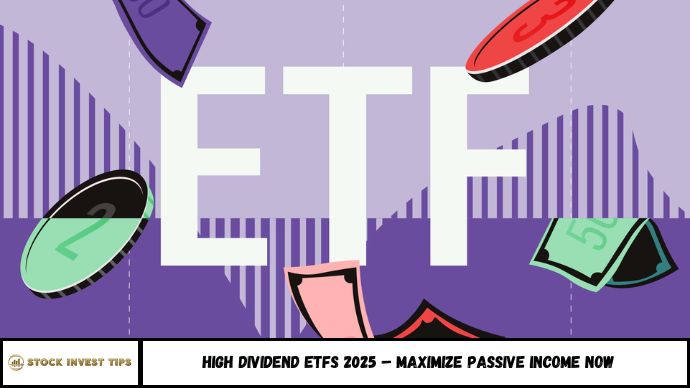Looking to grow passive income through reliable investments? This guide reveals the top high dividend ETFs for 2025, combining strong yields, low risk, and long-term potential. Discover the best options to diversify your portfolio and earn consistent income—without managing individual stocks.
In an era where inflation and market volatility threaten financial stability, passive income through dividends offers a lifeline. But selecting individual stocks can be time-consuming and risky.
That’s where dividend ETFs come in—bundling multiple high-yield assets into one fund, reducing risk, and generating consistent income. In this article, we’ll cover:
- What makes a good high dividend ETF
- The top dividend-paying ETFs for 2025
- Risks to watch for
- How to get started with as little as $100
Let’s uncover which ETFs can deliver strong returns in 2025 and help you build a more secure financial future.
Dividend stocks remain a favorite among income-focused investors. Their regular payouts can provide a steady stream of passive income, making them ideal for those looking to supplement their cash flow. Investors can also choose a total return strategy—or blend both approaches—to meet long-term financial goals.
For a more hands-off and diversified option, dividend ETFs offer a simple, efficient solution. Here’s why they’re so popular:
- Built-in diversification: These ETFs hold a wide range of dividend-paying stocks, reducing the risk of relying on any single company.
- Low costs: Most dividend ETFs come with low expense ratios, keeping more of your returns in your pocket.
- Ease of access: Traded like regular stocks, they’re easy to buy and sell through major brokerage platforms.
With many highly rated dividend ETFs managed by top firms, investors have no shortage of reliable options to gain exposure to dividend-paying equities—all in one convenient investment.
What Makes a Great High Dividend ETF?
Not all dividend ETFs are created equal. Look for funds that offer:
- High yield (4%+ annual return)
- Low expense ratios (under 0.75%)
- Strong diversification (across sectors or geographies)
- Consistent performance (positive 3-5 year track record)
Top 5 High Dividend ETFs to Buy in 2025
1. Vanguard High Dividend Yield ETF (VYM)
- Dividend Yield: ~3.2%
- Expense Ratio: 0.06%
- Why It’s Top: Holds over 400 U.S. companies. Low cost, wide diversification, and stable returns. Ideal for conservative investors.
2. iShares Select Dividend ETF (DVY)
- Dividend Yield: ~3.9%
- Expense Ratio: 0.38%
- Highlights: Focuses on U.S. companies with a history of high dividends. Heavily weighted in utilities and industrials.
3. Schwab U.S. Dividend Equity ETF (SCHD)
- Dividend Yield: ~3.6%
- Expense Ratio: 0.06%
- Key Strength: Favors companies with strong fundamentals and consistent dividend growth. Popular among long-term investors.
4. Global X SuperDividend ETF (SDIV)
- Dividend Yield: ~10%
- Expense Ratio: 0.58%
- Why Choose It: Targets 100 of the highest dividend-yielding companies globally. Higher risk, but great for aggressive income seekers.
5. JPMorgan Equity Premium Income ETF (JEPI)
- Dividend Yield: ~7.5%
- Expense Ratio: 0.35%
- Unique Strategy: Combines dividend income with covered call options for enhanced yield. Balances income with modest growth.
Dividend ETF Investing Strategies for 2025
Start Small and Reinvest
Even investing $100/month in a dividend ETF can snowball over time. Use dividend reinvestment plans (DRIPs) to maximize compounding returns.
Use Tax-Advantaged Accounts
Hold ETFs in Roth IRAs or 401(k)s to avoid tax on dividends and capital gains.
Balance High-Yield and Growth ETFs
Don’t chase the highest yield. Blend safer ETFs like VYM or SCHD with higher-risk ones like SDIV for balance.
Why 2025 Is a Strategic Year for Dividend ETFs
- Interest rates remain elevated, pressuring growth stocks and spotlighting income strategies.
- More investors are retiring: The number of retirees is projected to grow by 2.5 million in 2025, boosting demand for income assets.
- According to Statista (2024), U.S. dividend ETF assets under management (AUM) grew 14% year-over-year, reflecting growing investor interest.
Risks to Be Aware Of
- Dividend cuts during economic downturns
- Market volatility affecting ETF prices
- International ETFs (like SDIV) may have currency risks
Always review each fund’s holdings and historical dividend stability.
Frequently Asked Questions (FAQs)
1. What is a high dividend ETF?
A fund that holds stocks offering above-average dividend yields, designed to provide passive income.
2. Are dividend ETFs safe?
They’re generally safer than individual stocks due to diversification, but still carry market risk.
3. How much can I earn with $1,000 in dividend ETFs?
With an average 4% yield, you’d earn about $40/year, excluding compounding.
4. How do I buy a dividend ETF?
Use a brokerage platform like Fidelity, Schwab, or Robinhood. Search by ticker and invest.
5. Do dividend ETFs pay monthly?
Some do, like SDIV or JEPI. Others pay quarterly.
6. Can I lose money with dividend ETFs?
Yes. While dividends help, the ETF’s price can fall with the market
Conclusion
In 2025, high dividend ETFs offer one of the most reliable and low-effort paths to passive income. Whether you’re just starting out or expanding a retirement portfolio, ETFs like SCHD, VYM, or JEPI strike the right balance of yield, cost, and security.

